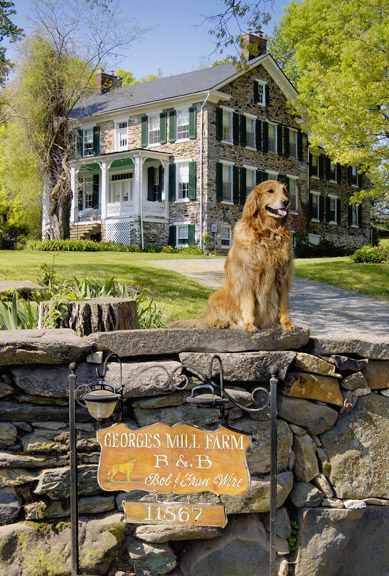Imposing brick, stone or wood mills once were a common sight around Loudoun, a sign of its thriving agricultural economy. They were usually among the first buildings to be constructed in the early settlements in the county, along with a church and a school. But today, there are few that survive.
On Saturday, however, a reminder of their former vital significance to the life of any community was brought to the Lovettsville Museum during the Lovettsville Historical Society’s Old Photo and Artifacts Day.
Bluemont resident Shirley Lynn arrived at the museum carrying a framed document bearing the signatures of close to 50 farmers supporting her ancestor John George’s 1774 petition to build a mill on The Great Dutchman run, today known as Dutchman’s Run, west of Lovettsville. George was the first of what would later become a large number of descendants to arrive in the county. Today’s far-flung George family boasts eight generations of living in Loudoun.
Lynn had heard of the historical society’s initiative through a distant cousin, Lovettsville resident Fred George, also a descendant of John George, who suggested she might want to take her framed petition to the museum. She did, and found her document the center of attention during the event.
Lynn said she doesn’t know how or why her father had the petition in his possession, noting her family were “”the Leesburg Georges,”” while Fred George is one of the Lovettsville Georges.
“”All I know is my father had it hanging on the wall at home. He valued it highly,”” she recalled. When her parents died, she inherited the petition, probably “”because I was the only one who was interested.”” The framed document was so fragile, Lynn was careful to keep it in a dark, dry place, only bringing it out to show family members occasionally.
Lynn’s grandfather was one of those Leesburg Georges. Wallace George had a large farm off Edwards Ferry Road, where he had what was known as the Wallace George airstrip, or the “”Cow Pasture Airport,”” later purchased by Arthur Godfrey.
Lynn’s grandfather was a substantial landowner and businessman, who at one time owned the ice plant in Leesburg and also had a half interest in the town’s electric company.
The interest the petition received Saturday as well as advice from historians has spurred Lynn to seek professional conservation advice from a paper conservator. “”It is so very fragile,”” she said. Although several institutions would probably dearly love to have the petition in their collections, Lynn intends to keep it and eventually pass it on in the family.
What is interesting is that Lynn’s petition regarding John George’s mill is not the only one in existence.Fran Wire, owner of the George’s Mill Bed & Breakfast inn west of Lovettsville where George’s Mill was situated, is the widow of Robert Wire, a descendant of John George through the female line. She also has a petition, almost the twin of Lynn’s record, but bearing significantly fewer signatures. Her son had found that document in the court archives in Leesburg and she has a record of the court proceedings showing George’s petition was approved March 11, 1774.
Lovettsville Historical Society President Tom Bullock was very interested to see the petitions. He has done a significant amount of mapping of historic properties and was able to match petition names to specific farms.
He surmised that the petition with the larger number of names, extending to a radius of between two and three miles, covered farmers likely to have intended to bring their crops to George’s Mill for milling, while the smaller petition probably covered just his immediate neighbors. The court, evidently, was interested in ensuring such projects had the support of all their neighbors. There is no record of the decision being made by a jury, and the level of support shown for John George’s mill likely indicated no hearing was considered necessary, Bullock said.
Fred George brought in a collection of George family portraits to be scanned, while Wire also brought her petition. Bullock noted the fragility of Lynn’s mill petition. “”The bugs had chewed it, but I was able to read 99 percent of the names,”” he said. Only one name was a duplicate, and was scratched out, he said.
Today, only a low stone wall is all that remains of either the original mill or a subsequent one, Wire said, noting its location near where the miller’s house once stood. By the Great Depression, the grist and lumber mill was no longer in commercial use. Instead, it was used as a dance floor, frequented by patrons who would come out to Lovettsville on weekends for a spot of fun. According to local lore, the disapproving members of the nearby Methodist Church predicted the structure would either be washed away or burn down as a result. It did neither. The family couldn’t afford to keep it up it, and reportedly people took wood from it to burn for firewood during the dark economic days of the Depression and it eventually collapsed on its own, Wire said.
George’s Mill Bed and Breakfast is located on George’s Mill Road, which runs through the farm. Many of the houses built on the property incorporated lumber from the mill. Wire said there used to be a big scale in front of the mill where livestock were weighed.
While the petition was the highlight of the day, Bullock said other interesting artifacts that surfaced Saturday included a model of a barn that was used by farmers to build their own structure. There was also an 1850 letter from a woman living near Lovettsville who wrote to a female relative about her moving west to Ohio with some other residents. Somewhat tartly, she informed her relative that this was the third time she had written to her about such a move and did not intend to write again until she had a reply.

